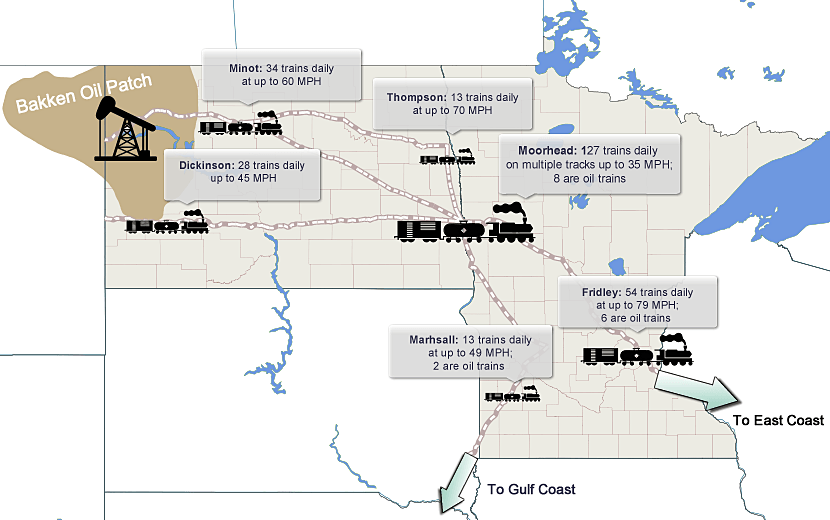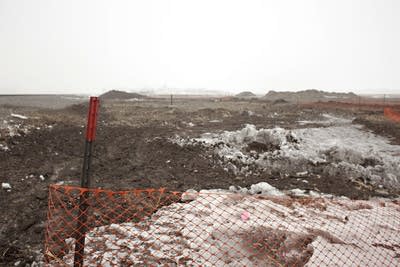As more oil trains roll, local firefighters worry, prepare for the worst

Go Deeper.
Create an account or log in to save stories.
Like this?
Thanks for liking this story! We have added it to a list of your favorite stories.
Some 70 trains a day roll through Moorhead on the Burlington Northern Santa Fe main line. Another track carries about 60 trains daily. They deliver a lot of frustration for local residents — and a lot of worry for local firefighters.
That worry became very real in December after a derailment, fire and explosions just across the state line in Casselton, N.D. — a near-disaster, triggered by crude oil cars from the Bakken oil fields.
Moorhead and other rail towns now are rethinking how well prepared they are for another Casselton. Federal lawmakers are asking questions and considering new laws. In St. Paul, legislators were expected to take up the rail safety issue at an informational hearing again Wednesday at the Capitol.
With more oil moving on the rails, it's understood that an accident with the highly flammable Bakken crude would likely overwhelm even the best trained firefighters.
Turn Up Your Support
MPR News helps you turn down the noise and build shared understanding. Turn up your support for this public resource and keep trusted journalism accessible to all.
"I think it just heightens the level of concerns we've always had," said Moorhead Assistant Fire Marshal Chad Stangeland. "You worry about the tracks non-stop for what's running up and down the rail lines. Those are the things that keep you up at night wondering 'What if?'"
One answer to that 'what if?' is training.
Moorhead firefighters didn't leave the fire station parking lot during a recent training session, but they tested equipment, and decision making.
Captain Gary Larsen briefed three firefighters in a mobile command trailer. The imaginary scene? Rail tank cars that are leaking. Not oil, in this scenario, but phosphoric acid and ammonia cars. "We have a big white cloud."

The firefighters test handheld chemical sensors that send readings to a laptop in the trailer.
In the mobile command trailer, a firefighter checks weather conditions and plots where the chemical cloud will spread. The same technology can predict a smoke plume from an oil fire.
The computer software gives a rough estimate of future toxic cloud movement but there's a lot of guesswork involved.
Stangeland, the hazmat team director, says there's much better equipment that provides detailed predictions and real time air quality measurements. But it comes with a high price tag, $50,000, and there's no money to buy that kind of gear.
When there's a railroad accident, companies like BNSF send in their own emergency response team, and they have the latest gear.
In the case of the explosion in Casselton last December, a BNSF crew from Arkansas, brought in the latest air monitoring equipment and software.
But that team arrived hours after the explosion. Local emergency planners say if there were a chemical spill in a populated area, that expertise would arrive too late.
Inside the fire station, Captain Ryan Muchow and officer Trent Amundsen work on an evacuation plan for their training scenario. Residential neighborhoods and the high school are near the derailment site.
There a lot of decisions to make. How large is the area to be evacuated? Where should people go? Should some residents close to the derailment be told to stay in their homes because it's too dangerous to leave?
An evacuation plan that looks easy on paper rarely plays out that way, Stangeland said. "How do you message four thousand people simultaneously, accurately, and with confidence to where people will understand the message and do what you anticipate?"
As the firefighters talk about setting up a decontamination station, and attempting to put a temporary patch on the leaking railroad car, a fire call ends the drill.
That's the reality of training in a small fire department.
There are 11 regional hazmat teams in Minnesota. All have equipment and training to monitor and respond to toxic spills and accidents. But there are 785 local fire departments in Minnesota, with dozens situated along railroad tracks. They are not required to report what kind of monitoring equipment they have to the division of Homeland Security and Emergency Management.
Local firefighters are encouraged but not required to take training.
Fargo and Moorhead both have hazmat teams. They often train together and back each other up on calls. Five to seven oil trains go through Fargo-Moorhead every day, and that number could increase to 10 or more later this year. Most of those trains also pass through the Twin Cities on the way to east coast refineries.

Are they ready if an oil train catches fire?
Even a well trained team can't do much in a situation like the Cassleton accident, Stangeland said. An explosion and fire get big too quickly. The best they can do is evacuate residents.
Truth is, an oil train derailment isn't his worst nightmare.
"People see a fire, an explosion, their natural reaction is to get away," he said. "But the challenge ends up being what do I do if I see a strange vapor cloud?"
BNSF won't say what kind of toxic materials are on trains. Federal law allows the railroad to keep that information private. But federal law also says railroads can't refuse to haul toxic materials.
Railroad companies have a responsibility to respond to accidents. Federal law says they must have a basic emergency response plan. But that plan is up to the railroad. There are no specific requirements in the law.
If a ship or barge hauls oil, the company needs a detailed spill response that meets federal standards, but there are no standards for the railroad's emergency plans, said Steve Lee, who manages the Minnesota Pollution Control Agency's emergency response program.
"It's like an unfinished recipe," he said. Companies need to have the equipment and the people, but there's nothing that says "how much and how many and how soon. And the other thing missing for the preparedness recipe in state law is the heat."
Lee says because there are no federal or state standards, it's very difficult to force a railroad to improve its response plan.
The state can hold unannounced drills to test emergency plans, but that's not done often because it's expensive and disruptive, Lee said. There hasn't been a drill since 2006.
Lee knows exactly what he wants state lawmakers to do and he says they have the authority to make the changes.
"I'd provide for training," he said. "I'd provide specific standards for response preparedness and I'd provide some state staff to help the companies meet those standards and to enforce standards."
Railroads have a good training program for firefighters and they spend a lot of money on equipment to respond to disasters, he added. But he questions whether that equipment can get to a disaster in time to make a difference.
He thinks a better plan would be for railroads to provide equipment for local first responders.
BNSF emergency response plans don't depend on local first responders.

The problem is that local fire departments have a wide range of training and equipment, said Patrick Brady, assistant director of hazardous materials for BNSF.
"We never know how prepared a community is going to be when we have an incident," he said. "So we don't rely heavily on what the community can or cannot bring to an incident."
BNSF won't say how much is spent on training for first responders, but Brady says this year BNSF will focus on training along its crude oil routes.
In Minnesota since 2009 BNSF has trained 730 first responders in 30 classes, a BNSF spokeswoman said. In North Dakota, the railroad trained about 700 first responders the past two years.
The company places equipment in strategic locations, Brady said. For example, a unit that sprays foam to fight chemical or oil fires is now stationed in Fargo.
Brady acknowledges response times vary depending on the location, but he says the company can respond quickly to an incident in populated areas where crews and equipment are stationed.
Brady says BNSF would oppose any state rules for emergency response planning. He says that would just make the company's job more difficult.
"Especially with the Moorhead-Fargo example — if you just cross the river it's a whole different structure," he said. "That patchwork from state to state becomes very difficult for us to comply with."
Despite the recent high profile crude oil fires, the rate of railroad accidents and derailments has steadily declined according to federal statistics.

But recent accidents have increased interest in rail safety.
The Minnesota Department of Public Safety has been working on oil train safety for more than a year, said Kevin Reed who manages the agency's emergency responses. "There's 15 fire department regions in Minnesota and I've been to all of their meetings talking about oil and trying to get them to make sure they understand this is coming, it's not going away."
Reed says he's encouraging small town volunteer fire departments to take advantage of BNSF training.
"I think the biggest thing is to get the word out so that these smaller departments that are along the rail can start talking to the rail about what's going on there and they can start preparing before anything happens," he said.
In Moorhead, hazmat director Stangeland also thinks about those small towns, because his team is backup for those volunteer firefighters.
The odds of a catastrophic accident are small because the railroad has a good safety record, Stangeland said. But when rail accidents do happen, he added, they're often big and they can quickly overwhelm even the most well prepared responders.






